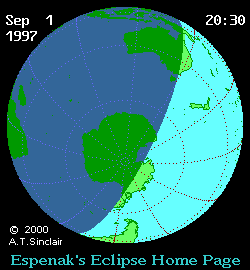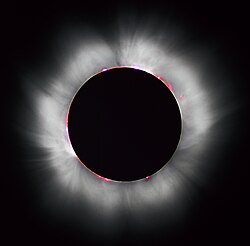| Partial eclipse | |
| Gamma | −1.0352 |
|---|---|
| Magnitude | 0.8988 |
| Maximum eclipse | |
| Coordinates | 71°48′S114°18′E / 71.8°S 114.3°E |
| Times (UTC) | |
| Greatest eclipse | 0:04:48 |
| References | |
| Saros | 125 (53 of 73) |
| Catalog # (SE5000) | 9502 |
A partial solar eclipse occurred at the Moon's ascending node of orbit between Monday, September 1 and Tuesday, September 2, 1997, [1] with a magnitude of 0.8988. A solar eclipse occurs when the Moon passes between Earth and the Sun, thereby totally or partly obscuring the image of the Sun for a viewer on Earth. A partial solar eclipse occurs in the polar regions of the Earth when the center of the Moon's shadow misses the Earth.
Contents
- Images
- Eclipse timing
- Places experiencing partial eclipse
- Eclipse details
- Eclipse season
- Related eclipses
- Eclipses in 1997
- Metonic
- Tzolkinex
- Half-Saros
- Tritos
- Solar Saros 125
- Inex
- Triad
- Solar eclipses of 1997–2000
- Saros 125
- Metonic series
- Tritos series
- Inex series
- References
- External links
A partial eclipse was visible for parts of Australia, Oceania, and Antarctica.







































































































